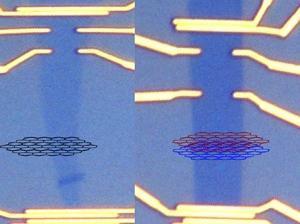Has the replacement for silicon been found that will enable the construction of more powerful computers and the continuation of Moore's Law?

Physicists from the University of Maryland have shown that in graphene the limit of internal mobility, a measure of a material's quality as an electrical conductor, is higher than any other known material at room temperature. Graphene, a surface one atom thick of graphite, is a new material that combines properties of semiconductors and metals. These results, published online in the journal "Nature Nanotechnology" imply that in the future graphene will be able to replace the semiconductors commonly used today, such as silicon, in applications ranging from high-speed computer chips to biochemical sensors.
A research team led by physics professor Michael Fuhrer from the University Center for Nanophysics and Advanced Materials, and the Center for Nanotechnology of the University of Maryland says that the findings are the first measure of the effect of vibrational vibration on the conductivity of electrons in graphene, and that the measured effect is unusually small. In any substance, the energy associated with the heat it contains causes the atoms in the substance to vibrate in place. As the electrons move through the material, they can break free from these vibrating atoms, creating electrical resistance. This resistance is a unique characteristic of each and every material: it cannot be completely eliminated except at absolute zero, and is therefore the upper limit to the degree of effectiveness of the material as an electrical conductor.
In graphene, the atoms vibrating at room temperature create a resistance of about one microohm/centimeter (resistance is a physical measure and is defined as the resistance of a part of the material multiplied by its length divided by its cross-section). This value is about thirty percent of the resistance of copper, the material with the lowest known resistance at room temperature. "Various impurity components present in today's graphene samples add a certain amount of resistance to graphene," explains the researcher, "so the total resistance is still not as low as that of copper at room temperature. However, graphene has a lower number of electrons than copper, so in graphene the electric current is carried by a smaller number of electrons that move faster than in copper."
In semiconductors, another measure, mobility [mobility, of a charged particle in an electric field] is used to quantify the speed of the electrons. The conductivity limit of the electrons in graphene is determined by the harmonic vibration of the atoms and is about 200,000 cm2/Vs at room temperature, compared to the value in zinc - 1,400 and indium antimonide - 77,000, which are common semiconductors with the highest conductivity. "Surprisingly, in semiconductors made of carbon nanotubes, which can be seen as a layer of graphene rolled to form a cylinder, we showed that the conductivity at room temperature is higher than 100,000," says the researcher.
The conductivity determines the speed at which an electronic device (such as: transistors, the basic components of contemporary computer chips) can be turned on and off. Its high conductivity ensures that graphene can be used for applications where the transistors are required for extremely fast operation, such as the processing of extremely high frequency signals. The conductivity can also be translated into the conductivity of a material in relation to its number of charge carriers, so high conductivity is also useful for chemical and biological sensing applications where a charged signal coming, for example, from a compound related to a device, is translated into an electrical signal by changing the conductivity of the components. Graphene could also have applications in the areas of strength of materials, thickness of conductive materials, electrical conductivity and transparent coatings.
The researchers showed that although the room temperature conductivity limit of graphene is as high as 200,000 cm^2/Vs, in today's samples the resulting practical conductivity is only about 10,000, so there is still much room for improvement. Since the thickness of the graphene is only one atom, the current samples must be placed on other substrates, in this case - nitrogen dioxide. Electric charges trapped in the carbon dioxide itself (which is a type of atomic pollution in this system) can affect the electrons in the graphene and reduce their conductivity. In addition, vibration of the atoms of the substrate itself can also affect the graphene, a greater effect than its own. The researchers believe that in the future it will be possible to reduce these negative effects and make them disappear altogether.

7 תגובות
Silicon has a much slower mobility index than indium antimonide (1,400 compared to 77,000). Are there processors made of indium antimonide?
To Ethan, I loved it
to Michael Thanks for the referral.
A. Ben-Ner:
See here: http://en.wikipedia.org/wiki/Graphene
Under the heading Chemical modification and in the chapter History and Experimental Discovery
The first method I heard of to separate one layer of graphene from graphite is adhesive paper, how simple and genius. I don't know how to do it today.
In principle, semiconductors are able to produce a thickness of one atomic layer by the method of condensing atoms on a substrate surface. I don't think it's possible to do it on carbon atoms and get graphene because they also need a very high temperature and differ in size and shape from the substrates they use, but you have to check, I'm not sure.
How do you produce a surface with a thickness of one atom and more without having gaps in it?
Electrolysis or something more sophisticated?
The question is whether it is graphene in the sense of groupen or groupen in the sense of graphene?